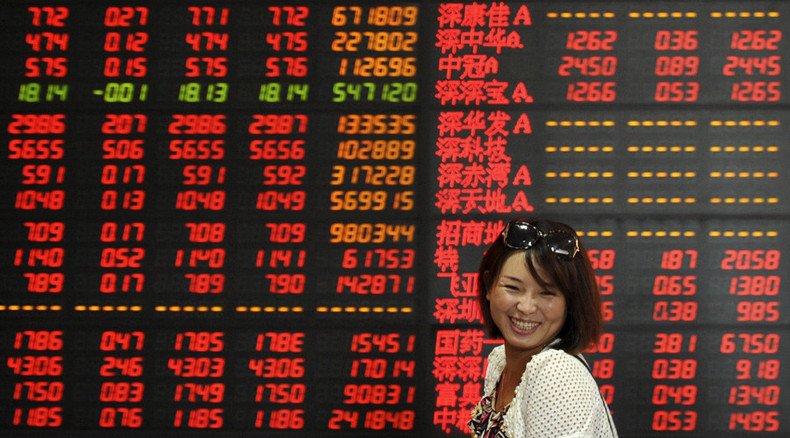What’s the real story behind the $3.8 trillion Chinese correction?

The recent Mother of All Corrections in Chinese stocks – which wiped out a $3.8 trillion on paper - inevitably led the usual US “experts” to forecast, once again, China's imminent collapse. Hong Kong even resuscitated the “regime change” meme.
Nonsense.
The roller coaster lasted a few days. And then it was gone. Significantly, major US funds – including Fidelity and Goldman Sachs – were among the first to declare the turbulence over, and move on. Goldman Sachs, by the way, soon reverted to bullish. Its chief China economist, Kinger Lau, predicted that Shanghai will rally 27 percent over the next 12 months.
So this is not a bubble. At least not yet. Beijing has a lot of tools to – as newspeak goes - “support the market.” According to Little Helmsman Deng Xiaoping’s maxim, “Socialism with Chinese characteristics,” which will stop at nothing to control the “irrational exuberance” of the markets.
READ MORE: China’s Shenzhen stock skyrockets, shows biggest growth since 2012
The IMF – considering its disaster capitalism record all across the developing world, not to mention the post-1997 Asian financial crisis – is never a reliable source. But in this case, IMF chief economist Olivier Blanchard at least did not make a fool of himself; he emphasized China’s casino stock market “doesn’t reflect on the fundamentals” of its economy. The slump, he added, “was very much a sideshow.”
To get rich is a casino
China’s stock market is dominated by small investors. Roughly 5 percent to 6 percent of China’s 1.4 billion people – a nation of inveterate gamblers – relish playing the stock market. Individuals account for 80 percent of trading in Shanghai and Shenzhen. Yet this accounts for only 32 percent of China’s GDP – compared to the whopping 123 percent in America’s case, and at least 100 percent for most developed nations.
True, these investors, after the recent shellacking, will become more prudent, and Chinese consumption as a whole may slow down. But the financial pain in fact applies to no more than 30 million Chinese households – and most of them range from upper-middle-class to the very wealthy, according to financial services outfit GaveKal.
READ MORE: China’s central bank injects $8.2bn to sooth market collapse
There may be further corrections down the road. But then, at least they learned.
Beijing has spent a lot of political and economic capital to make Shanghai a globally accepted capital market; in sum, the new Hong Kong. That’s also connected a drive to establish the yuan as a true global currency. And economic success is the key vector in President Xi Jinping’s project of realizing the “Chinese dream”.
It’s always important to remember that Xi’s “Chinese dream,” short-term, is already focused on a key date, 2021; that’s the centenary of the founding of the Chinese Communist Party. By then, Xi expects to have established China as a “moderately prosperous society.”
Those 30 million households addicted to the idea that “to get rich is glorious” – yet another Deng maxim - that’s fine. But for Beijing, even more important is the power legitimacy yielded by caring about the average Chinese.
For instance, over 13.2 million urban jobs were created in 2014, more than in 2013. And there are more new businesses, an increase of 45.9 per cent, compared to the year before. Consumption and services continue to grow in relation to GDP. The overall trend – forgotten in the rubble of stock slump hysteria – is that China's economic model is slowly but surely shifting towards more moderate - but more sustainable - growth.
Last but not least, China grew 7 percent in the second quarter of 2015 – leaving the usual prophets of doom with their mouths agape.
The attack of the killer speculators
Beijing knows that a prolonged bear market might affect corporate financing, wreak havoc in the tweaking of the economic shift, and even pose a serious political risk for the leadership.
READ MORE: China freezes IPOs to stop rapid stock market decline - report
After some hesitation by the leadership on how to “save” the market, Premier Li Keqiang – a PhD in economics - chaired a State Council meeting, and the whole machine went into full crisis management, swiftly correcting the correction. As Ma Guoxian, a political economist at Shanghai University of Finance and Economics put it, "the government has apparently put financial stability and social stability over the long-term agenda of market reform to develop its capital markets."
And there’s also the short-term angle as well. Beijing needs a bull market back ahead of the annual leadership summit at the seaside resort of Beidaihe near Beijing next month.
No wonder the notion that this Mother of all Corrections, which was a setup, also started getting a lot of traction. A setup by Wall Street speculators is tied to saber rattling by the Pentagon over those offshore islands in the South China Sea, and also geared to punish China for its strategic partnership with Russia. This is no conspiracy theory; I learned it from US executives whose companies have a strong presence in the Chinese market.
READ MORE: China’s stock market bounces back, after govt steps in to stop huge slide
They mentioned 1987 as a precedent, when major US houses first manipulated the markets up using cash settlement, and then crashed it by cash settlement maneuvers. The engineered plunge in New York in 1987 might have wiped out the entire US capital market. The Fed then intervened, forcing the manipulators to reverse their positions in cash settlement.
So according to these US executives, Beijing was absolutely correct to intervene this time to save their capital market. The bottom line is that in casino capitalism as favored by the Neoliberal Gods, all markets are manipulated.
Beijing does not believe that unrestricted financial markets per se may organize the economic growth of a nation; they are just a tool in a varied toolbox.
They also know that the dance of capital in the global roulette – predominating over productive capital – explained a good deal of the artificial boom in Shanghai paper. So Beijing may have taken a while to act. But when it did, it was Terminator-style.
The Middle Kingdom strikes back
Even the OECD has sounded the alarm – in vain; global mega-corporations and institutional investors are sitting on no less than $57 trillion, the equivalent of 120 percent of the total GDP of all industrialized nations. But they don’t invest in production, just speculation.
Why? Because – at least in the West – there are no jobs; demand is stagnated, or falling; there’s no public drive towards investment; there are no big infrastructure projects. That’s not the case in Asia – and especially in China.
READ MORE: World Bank urges China to hasten reform of ‘distorted’ state-dominated financial sector
Seven years after the implosion of the Brave New Neoliberal Order, in 2008, fixed investment in the industrialized North is 17 percent below 2008. Productive foreign investment fell in 2014. Meanwhile, inequality has gone crazy; in the industrialized North, the average wealth of the top 10 percent is ten times the average wealth of the lower 10 percent (it used to be between seven- or maximum eight-times a generation ago.)
So in a nutshell what we have is a wealthy rentier mentality gone amok, engineering bubbles that then turn into crashes. Beijing, with its intervention, said enough is enough. And additionally sent a clear message to speculators/market manipulators, which may or may not have included “official” Washington (the US Treasury Department, by the way, rejected any responsibility); forget about planning an attack on our financial market. It’s quite significant that the China Securities Regulatory Commission has launched a criminal investigation.
Assuming our US executives are right, and Wall Street speculators did launch an attack, the endgame would be to smash, or at least dent, the Chinese drive towards nothing less than Eurasia integration.
It’s China – from the New Silk Roads to the AIIB bank and its leading role in the BRICS’s New Development Bank as well – which is the major player in financing a series of major banking, infrastructure, and development projects that totally bypass the global hegemon.
So Beijing wins this round. There will be others. See you in the next Mother of All Corrections.
Pepe Escobar
The statements, views and opinions expressed in this column are solely those of the author and do not necessarily represent those of RT.
The statements, views and opinions expressed in this column are solely those of the author and do not necessarily represent those of RT.













